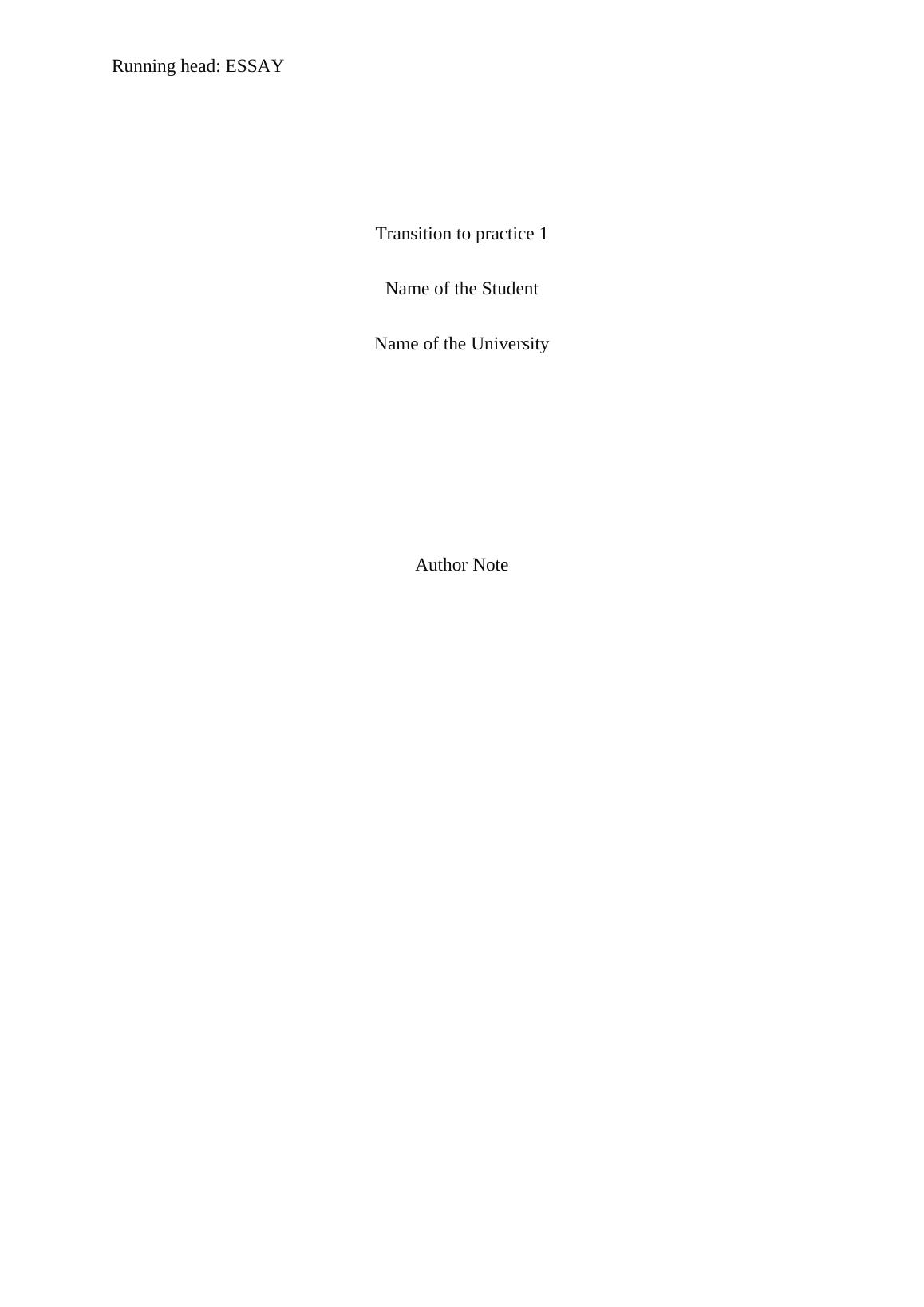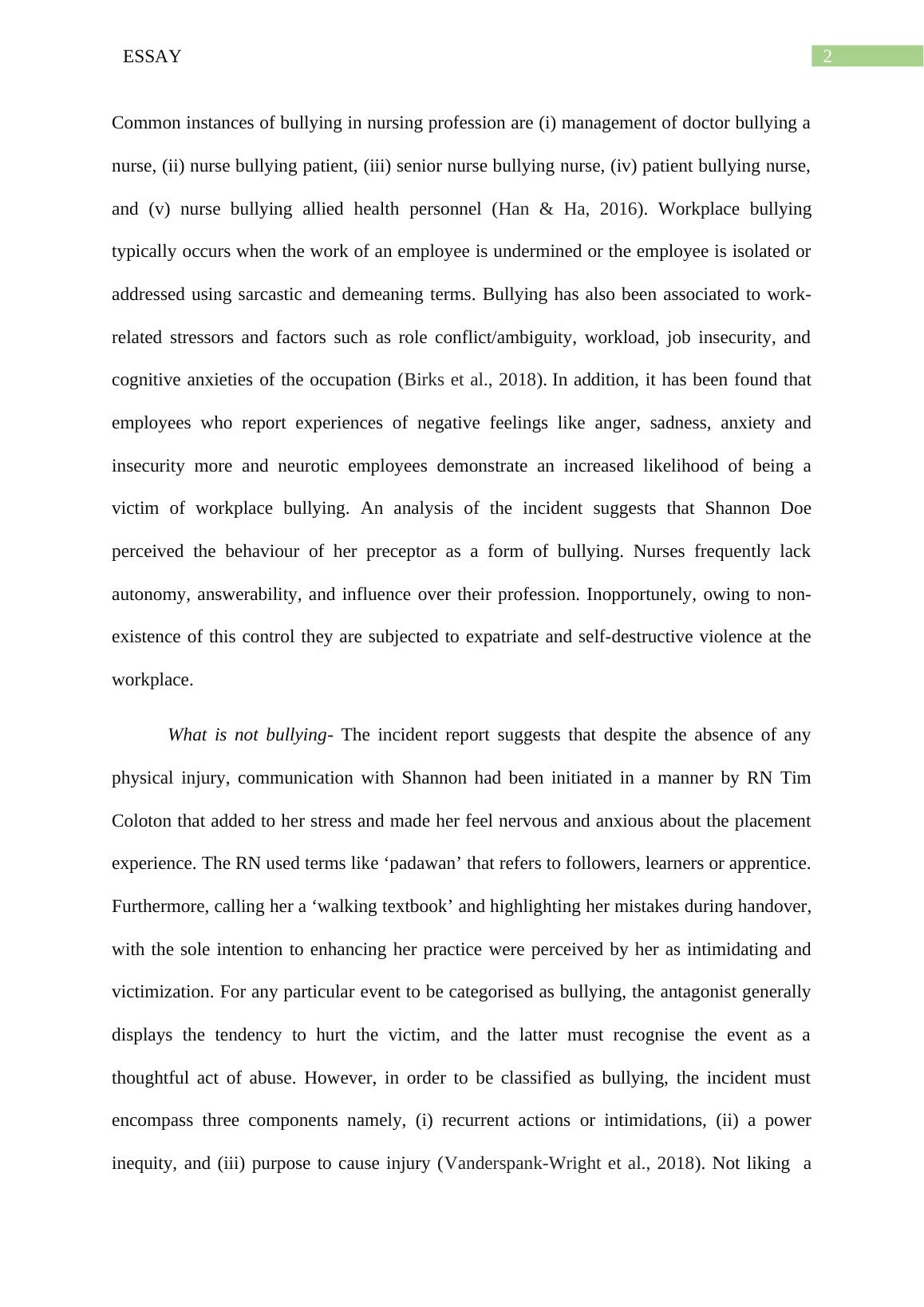Transition to practice: ESSAY 1 1 Transition to practice
Added on 2022-08-19
7 Pages1726 Words491 Views
Running head: ESSAY
Transition to practice 1
Name of the Student
Name of the University
Author Note
Transition to practice 1
Name of the Student
Name of the University
Author Note

ESSAY1
Introduction- Novice graduate nurses face a range of challenges that create a
significant negative impact on their successful transition to nursing practice. In the always-
changing environment of health and social care, the demand for nurses remain unaltered
(Lea, 2018). However, clinical nursing practices are currently under pressure for functioning
in an efficient and lean manner, owing to the decreased reimbursements, increased
consumerism, workplace aggression, and upsurge in regulatory oversight (Vanderspank-
Wright et al., 2018). Incident reporting refers to the mechanism by which healthcare
professionals disclose details about unintended physical or emotional injury caused by
another professional or the system. This essay will elucidate the incident reporting that
involves workplace bullying.
What is bullying- Workplace bullying refers to the tenacious pattern of maltreatment
from individuals in the workplace, which eventually results in either emotional or physical
harm. It generally comprises of tactics such as, nonverbal, verbal, physical, psychological
abuse, and humiliation (Mikkelsen et al., 2020). This kind of workplace bullying is
predominantly challenging owing to the fact that unlike the characteristic school bully,
bullies at the workplace frequently function within the recognised rules and dogmas of their
association and their wider community. According to Karatza et al. (2016) bullying is
generally covert or overt and its negative impacts are not restricted to the targeted persons,
and result in a debility in employee confidence and alteration in organizational culture.
Despite the stellar status associated with the nursing profession, nurses are subjected
frequently to the hidden culture of bullying, hazing disruptive behaviour and name-calling, all
across the globe.
When and where does workplace bullying/harassment occur- The nursing workplace
has been recognised as a domain that is characterised by recurrent workplace bullying and it
is commonly regarded that relational aggression like intimidation and gossiping are pertinent.
Introduction- Novice graduate nurses face a range of challenges that create a
significant negative impact on their successful transition to nursing practice. In the always-
changing environment of health and social care, the demand for nurses remain unaltered
(Lea, 2018). However, clinical nursing practices are currently under pressure for functioning
in an efficient and lean manner, owing to the decreased reimbursements, increased
consumerism, workplace aggression, and upsurge in regulatory oversight (Vanderspank-
Wright et al., 2018). Incident reporting refers to the mechanism by which healthcare
professionals disclose details about unintended physical or emotional injury caused by
another professional or the system. This essay will elucidate the incident reporting that
involves workplace bullying.
What is bullying- Workplace bullying refers to the tenacious pattern of maltreatment
from individuals in the workplace, which eventually results in either emotional or physical
harm. It generally comprises of tactics such as, nonverbal, verbal, physical, psychological
abuse, and humiliation (Mikkelsen et al., 2020). This kind of workplace bullying is
predominantly challenging owing to the fact that unlike the characteristic school bully,
bullies at the workplace frequently function within the recognised rules and dogmas of their
association and their wider community. According to Karatza et al. (2016) bullying is
generally covert or overt and its negative impacts are not restricted to the targeted persons,
and result in a debility in employee confidence and alteration in organizational culture.
Despite the stellar status associated with the nursing profession, nurses are subjected
frequently to the hidden culture of bullying, hazing disruptive behaviour and name-calling, all
across the globe.
When and where does workplace bullying/harassment occur- The nursing workplace
has been recognised as a domain that is characterised by recurrent workplace bullying and it
is commonly regarded that relational aggression like intimidation and gossiping are pertinent.

ESSAY2
Common instances of bullying in nursing profession are (i) management of doctor bullying a
nurse, (ii) nurse bullying patient, (iii) senior nurse bullying nurse, (iv) patient bullying nurse,
and (v) nurse bullying allied health personnel (Han & Ha, 2016). Workplace bullying
typically occurs when the work of an employee is undermined or the employee is isolated or
addressed using sarcastic and demeaning terms. Bullying has also been associated to work-
related stressors and factors such as role conflict/ambiguity, workload, job insecurity, and
cognitive anxieties of the occupation (Birks et al., 2018). In addition, it has been found that
employees who report experiences of negative feelings like anger, sadness, anxiety and
insecurity more and neurotic employees demonstrate an increased likelihood of being a
victim of workplace bullying. An analysis of the incident suggests that Shannon Doe
perceived the behaviour of her preceptor as a form of bullying. Nurses frequently lack
autonomy, answerability, and influence over their profession. Inopportunely, owing to non-
existence of this control they are subjected to expatriate and self-destructive violence at the
workplace.
What is not bullying- The incident report suggests that despite the absence of any
physical injury, communication with Shannon had been initiated in a manner by RN Tim
Coloton that added to her stress and made her feel nervous and anxious about the placement
experience. The RN used terms like ‘padawan’ that refers to followers, learners or apprentice.
Furthermore, calling her a ‘walking textbook’ and highlighting her mistakes during handover,
with the sole intention to enhancing her practice were perceived by her as intimidating and
victimization. For any particular event to be categorised as bullying, the antagonist generally
displays the tendency to hurt the victim, and the latter must recognise the event as a
thoughtful act of abuse. However, in order to be classified as bullying, the incident must
encompass three components namely, (i) recurrent actions or intimidations, (ii) a power
inequity, and (iii) purpose to cause injury (Vanderspank-Wright et al., 2018). Not liking a
Common instances of bullying in nursing profession are (i) management of doctor bullying a
nurse, (ii) nurse bullying patient, (iii) senior nurse bullying nurse, (iv) patient bullying nurse,
and (v) nurse bullying allied health personnel (Han & Ha, 2016). Workplace bullying
typically occurs when the work of an employee is undermined or the employee is isolated or
addressed using sarcastic and demeaning terms. Bullying has also been associated to work-
related stressors and factors such as role conflict/ambiguity, workload, job insecurity, and
cognitive anxieties of the occupation (Birks et al., 2018). In addition, it has been found that
employees who report experiences of negative feelings like anger, sadness, anxiety and
insecurity more and neurotic employees demonstrate an increased likelihood of being a
victim of workplace bullying. An analysis of the incident suggests that Shannon Doe
perceived the behaviour of her preceptor as a form of bullying. Nurses frequently lack
autonomy, answerability, and influence over their profession. Inopportunely, owing to non-
existence of this control they are subjected to expatriate and self-destructive violence at the
workplace.
What is not bullying- The incident report suggests that despite the absence of any
physical injury, communication with Shannon had been initiated in a manner by RN Tim
Coloton that added to her stress and made her feel nervous and anxious about the placement
experience. The RN used terms like ‘padawan’ that refers to followers, learners or apprentice.
Furthermore, calling her a ‘walking textbook’ and highlighting her mistakes during handover,
with the sole intention to enhancing her practice were perceived by her as intimidating and
victimization. For any particular event to be categorised as bullying, the antagonist generally
displays the tendency to hurt the victim, and the latter must recognise the event as a
thoughtful act of abuse. However, in order to be classified as bullying, the incident must
encompass three components namely, (i) recurrent actions or intimidations, (ii) a power
inequity, and (iii) purpose to cause injury (Vanderspank-Wright et al., 2018). Not liking a

End of preview
Want to access all the pages? Upload your documents or become a member.
Related Documents
Bullying and Incivility in Nursing: A Literature Reviewlg...
|24
|5468
|78
